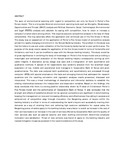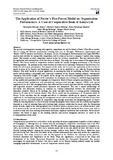| dc.description.abstract | The apex of environmental scanning with regard to competition can only be found in Porter’s Five Forces model.
This is a long side External environment scanning tools such as Strengths, Weaknesses, Opportunities and
Threats (SWOT) analysis and Political, Economic, Social, Technological, Environmental and Legal (PESTEL)
analysis and calculate its coping with competition, how to retain or increase a company’s market share among
others. This requires accurate competitive analysis in the face of these complexities. This may adversely affect
the application and continued use of the five forces in Kenya. This study was an assessment of the application of
Porter’s Five forces model of competitive analysis amidst the rapidly changing environment in the Kenyan
Banking industry. The problem in this study was that the failure to use and under-utilisation of the five forces by
banks has led to poor performance. The purpose of the study was to assess the application of the five forces
model in terms of its benefits and limitations, and how it can be modified to cope with the Kenyan banking
industry. This study would be of great significance in enriching the body of knowledge on Porter’s five forces
model and providing a meaningful and contextual evaluation of the Kenyan banking industry consequently
coming up with useful insights. A descriptive survey design was used and a triangulation of both quantitative
and qualitative methods. A sample of 62 respondents was randomly selected from the stratified target population
of top, middle and operational level managers in Cooperative Bank of Kenya and given questionnaires. The data
was analyzed both qualitatively and quantitatively and processed through computer (SPSS) with special
emphasis on the facts and emerging themes that addressed the research questions and the resulting correlation
and regression analyses results presented, discussed and interpreted. This was a mixed methodology of
descriptive and inferential statistics to establish the existing relationships between the independent and
dependent variables. Based on the findings, this study concludes that there is a strong positive relationship
shown by R value of 0.8 between Porter’s Five Forces model and the performance of Cooperative Bank of
Kenya. It also concludes that the strength and effects of substitutes should not be ignored; competitors are
significant in benchmarking, keeping the management on toes and increasing efficiency and effectiveness thus
aiding in success and achievement of competitive edge through innovation; the Bargaining power of buyers
within the banking industry is critical in terms of understanding the bank’s buyers and successfully meeting their
demands as a way of retaining them and achieving high customer satisfaction for repeat sales; the Bargaining
power of sellers apply to the banking industry was a factor to watch as increase in the cost of their services leads
to an increase in the cost of services offered by Cooperative Bank and the quality of their services also such as
assured security and clean working environment determines employee motivation and satisfaction. Threat of new
entrants was found to apply to the banking industry and needed mitigation measures as stated in the
recommendations of the study. | en_US |


